Building a Strong Recall: How to Train Your Dog to Come When Called
A strong recall is one of the most important skills your dog can learn. It ensures their safety, your peace of mind, and can even save their life in dangerous situations.
We will explore the steps and techniques to train your dog to come when called, even in the face of distractions. We will also discuss the importance of consistency and reinforcement in maintaining your dog’s recall skills.
And remember to check out our other articles on dog obedience training and positive reinforcement for more insights on effective dog training techniques.
| Key Takeaways: Building a Strong Recall |
|---|
| Establish a solid foundation for recall training by starting in a controlled environment with minimal distractions. |
| Gradually increase the level of difficulty by adding distractions and practicing in different settings. |
| Use high-value treats, create positive associations, and practice the ‘Surprise Party’ technique to boost recall response. |
| Consistently reinforce your dog’s recall skills by practicing regularly and rewarding their successes. |
| Be patient and remember that building a reliable recall takes time and persistence. |
Establishing a Solid Foundation for Recall Training
Building a reliable recall starts with creating a strong foundation. First, choose a unique cue or command that you will use consistently, like “come” or “here.” Make sure this cue is not used in other contexts, as it could confuse your dog. Then, build a positive association with the cue by rewarding your dog with treats, praise, or play every time they respond correctly.
Start your recall training in a controlled, low-distraction environment, such as your living room or a fenced-in yard. Keep your dog on a leash or long line to ensure safety and control.
With your dog at a short distance, say the cue, and reward them when they come to you. Gradually increase the distance between you and your dog as they become more reliable. Remember, patience and timing are crucial for successful recall training.

Gradually Introducing Distractions
A reliable recall means your dog comes when called, even with distractions present. Begin by introducing controlled distractions during training, such as having a family member walk by or placing a favorite toy nearby. Reward your dog for successfully ignoring the distraction and responding to your recall cue.
As your dog improves, gradually increase the difficulty of the distractions. Practice recall in various environments, like parks or busy streets, to help your dog generalize the skill. Keep your dog in a long line in these situations to ensure their safety.
Building Distance and Reliability
To build distance and reliability in your dog’s recall, start by increasing the distance between you and your dog in small increments. Focus on consistency, rewarding your dog every time they respond correctly. As your dog becomes more reliable at longer distances, continue to practice in different environments to help them generalize the skill.
It’s essential to understand your dog’s body language and recognize when they’re becoming disinterested or overwhelmed. Adjust your training sessions accordingly to keep your dog engaged and motivated.
3 Simple Tips to Boost Your Dog’s Recall Training
Here are three simple, yet highly effective tips to make your recall training more effective.
1. Use High-Value Treats
One of the most effective ways to reinforce your dog’s recall is by using high-value treats. These are treats your dog absolutely loves and doesn’t get very often. The idea is to make coming back to you the most rewarding experience for your dog.
Whenever they respond to the recall command, reward them with a high-value treat, making it more likely they will come when called in the future. Remember to always carry some of these special treats with you during training sessions.
2. Create a Positive Association with the Recall Command
It’s essential that your dog associates the recall command with positive experiences.
To achieve this, only use the recall command in a positive context. For example, avoid calling your dog to come when it’s time to leave the dog park or to give them medication, as this may create a negative association with the command.
Instead, use the recall command during playtime, before feeding them, or when offering a treat. This will help your dog develop a strong, positive connection with the command, making them more likely to respond when called.
3. Practice the ‘Surprise Party’ Technique
The ‘Surprise Party’ technique is a fun and engaging way to boost your dog’s recall training. The idea is to surprise your dog by calling them to come when they least expect it.
For example, when your dog is playing in the backyard or sniffing around the house, suddenly call them to come to you. When they respond, throw a ‘surprise party’ by showering them with praise, treats, and affection.
This technique makes the recall command an exciting and unpredictable event for your dog, which will help to strengthen their recall response.
There are also some key points that can help you to properly execute the reliable recall, check out the website.

Advanced Recall Training Techniques and Tips
For more advanced recall training, consider using a long line for added safety and control.
This allows your dog to practice recalls at greater distances while still providing you with control. Incorporate “sit” and “stay” commands into your recall training to further challenge your dog and ensure they respond to multiple cues.
Whistle training can also be a useful tool for distance recalls. The sound of a whistle carries farther than a human voice and can be easily heard by your dog. Practice using the whistle in conjunction with your recall cue to help your dog associate the two.
Ensuring Your Dog’s Safety During Recall Training
Safety should always be a top priority during recall training. Use a secure collar or harness to prevent your dog from slipping out during training sessions.
Practice recall in safe, enclosed areas, such as fenced yards or dog parks, to minimize the risk of your dog running off or getting into a dangerous situation. Always have your dog on a leash or long line when practicing in public areas or near traffic.
Maintaining and Reinforcing Your Dog’s Recall Skills
Consistent reinforcement is crucial for maintaining your dog’s recall skills. Continue to practice recall regularly, even after your dog has mastered the command. Reward them intermittently to keep them motivated and engaged.
Reinforcement can come in the form of treats, praise, or playtime. Remember, positive reinforcement is the key to successful dog training.
In addition to regular training sessions, incorporate recall practice into your daily routine. Call your dog to come when it’s time for dinner, a walk, or a game of fetch. This helps to solidify the recall command as a part of your dog’s everyday life.
And Finally
Training your dog to come when called is an essential skill that ensures their safety and strengthens the bond between you and your dog.
By building a solid foundation, gradually introducing distractions, and reinforcing your dog’s recall skills, you’ll have a well-trained dog that responds reliably, even in challenging situations.
Remember to be patient, and consistent, and to use positive reinforcement techniques for the most effective training. For more tips and tricks on dog training, check out our articles on long-distance commands and operant conditioning for dogs.
Brain Training For Your Dog




